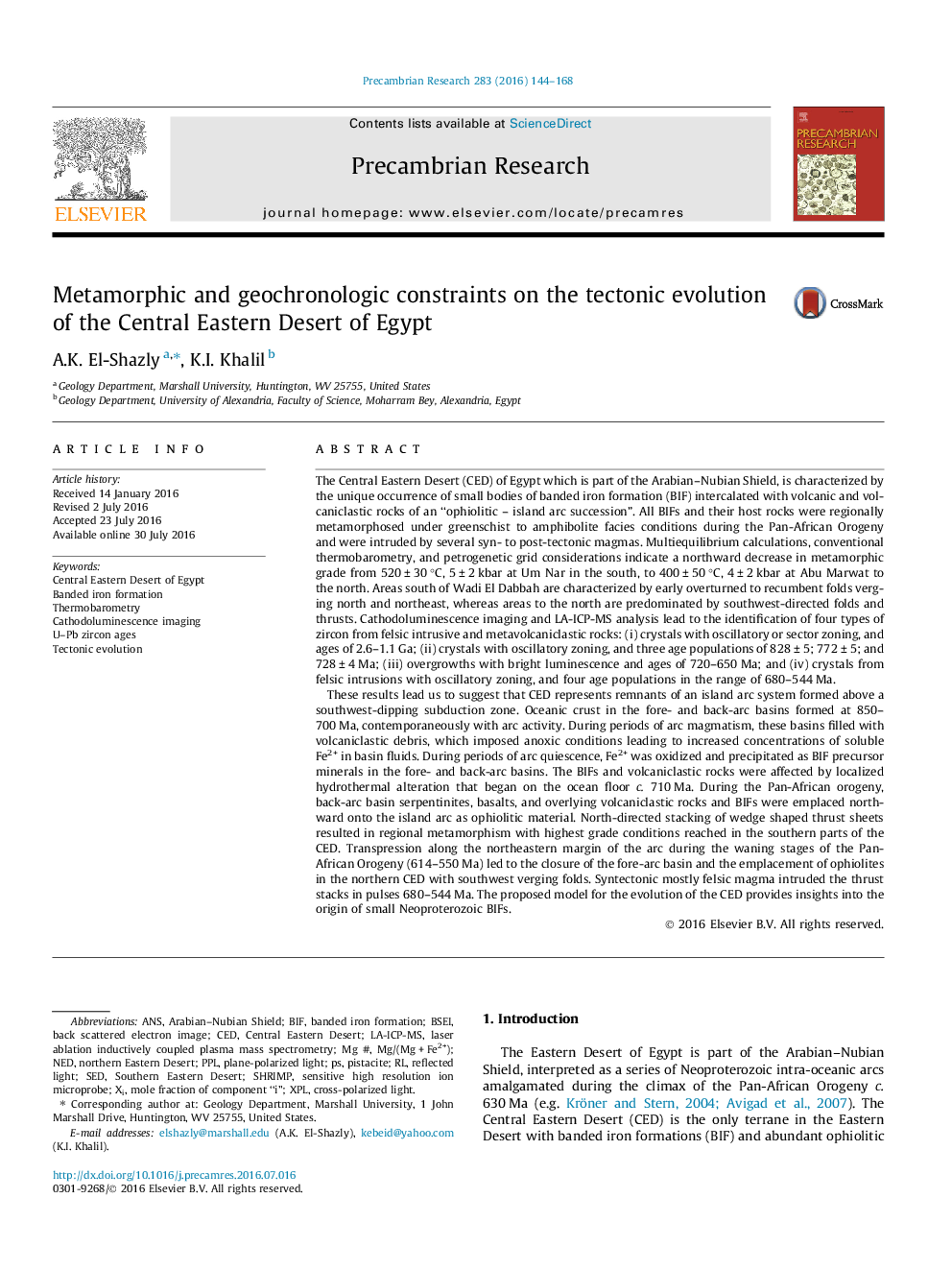| کد مقاله | کد نشریه | سال انتشار | مقاله انگلیسی | نسخه تمام متن |
|---|---|---|---|---|
| 4722328 | 1639592 | 2016 | 25 صفحه PDF | دانلود رایگان |
• Egyptian Central Eastern Desert characterized by Neoproterozoic banded iron formations.
• Metamorphic grade in CED decreases from south to north.
• Arc activity in three main pulses at 828, 772, and 728 Ma.
• BIF volcanogenic in origin formed in fore- and back-arc basins.
• Collisional stage of Pan-African orogeny began 680 Ma.
The Central Eastern Desert (CED) of Egypt which is part of the Arabian–Nubian Shield, is characterized by the unique occurrence of small bodies of banded iron formation (BIF) intercalated with volcanic and volcaniclastic rocks of an “ophiolitic – island arc succession”. All BIFs and their host rocks were regionally metamorphosed under greenschist to amphibolite facies conditions during the Pan-African Orogeny and were intruded by several syn- to post-tectonic magmas. Multiequilibrium calculations, conventional thermobarometry, and petrogenetic grid considerations indicate a northward decrease in metamorphic grade from 520 ± 30 °C, 5 ± 2 kbar at Um Nar in the south, to 400 ± 50 °C, 4 ± 2 kbar at Abu Marwat to the north. Areas south of Wadi El Dabbah are characterized by early overturned to recumbent folds verging north and northeast, whereas areas to the north are predominated by southwest-directed folds and thrusts. Cathodoluminescence imaging and LA-ICP-MS analysis lead to the identification of four types of zircon from felsic intrusive and metavolcaniclastic rocks: (i) crystals with oscillatory or sector zoning, and ages of 2.6–1.1 Ga; (ii) crystals with oscillatory zoning, and three age populations of 828 ± 5; 772 ± 5; and 728 ± 4 Ma; (iii) overgrowths with bright luminescence and ages of 720–650 Ma; and (iv) crystals from felsic intrusions with oscillatory zoning, and four age populations in the range of 680–544 Ma.These results lead us to suggest that CED represents remnants of an island arc system formed above a southwest-dipping subduction zone. Oceanic crust in the fore- and back-arc basins formed at 850–700 Ma, contemporaneously with arc activity. During periods of arc magmatism, these basins filled with volcaniclastic debris, which imposed anoxic conditions leading to increased concentrations of soluble Fe2+ in basin fluids. During periods of arc quiescence, Fe2+ was oxidized and precipitated as BIF precursor minerals in the fore- and back-arc basins. The BIFs and volcaniclastic rocks were affected by localized hydrothermal alteration that began on the ocean floor c. 710 Ma. During the Pan-African orogeny, back-arc basin serpentinites, basalts, and overlying volcaniclastic rocks and BIFs were emplaced northward onto the island arc as ophiolitic material. North-directed stacking of wedge shaped thrust sheets resulted in regional metamorphism with highest grade conditions reached in the southern parts of the CED. Transpression along the northeastern margin of the arc during the waning stages of the Pan-African Orogeny (614–550 Ma) led to the closure of the fore-arc basin and the emplacement of ophiolites in the northern CED with southwest verging folds. Syntectonic mostly felsic magma intruded the thrust stacks in pulses 680–544 Ma. The proposed model for the evolution of the CED provides insights into the origin of small Neoproterozoic BIFs.
Journal: Precambrian Research - Volume 283, September 2016, Pages 144–168
